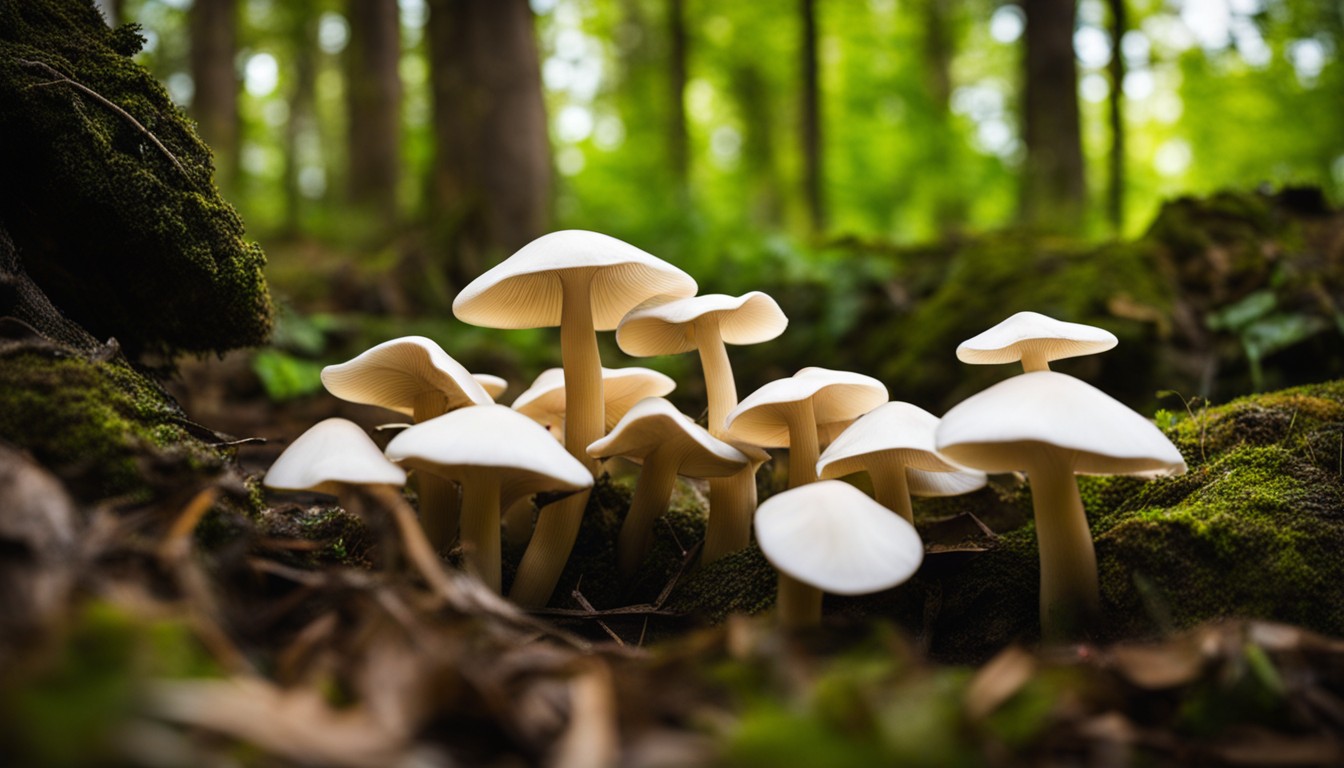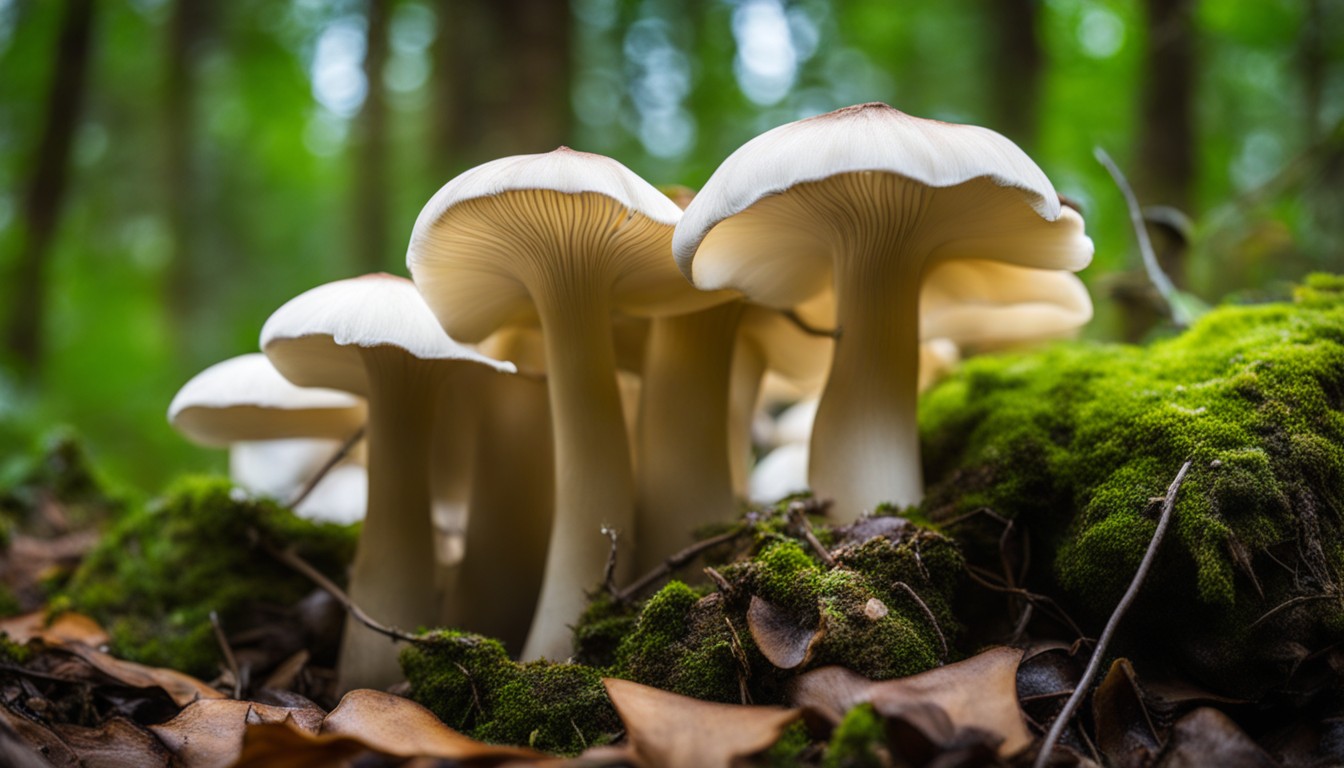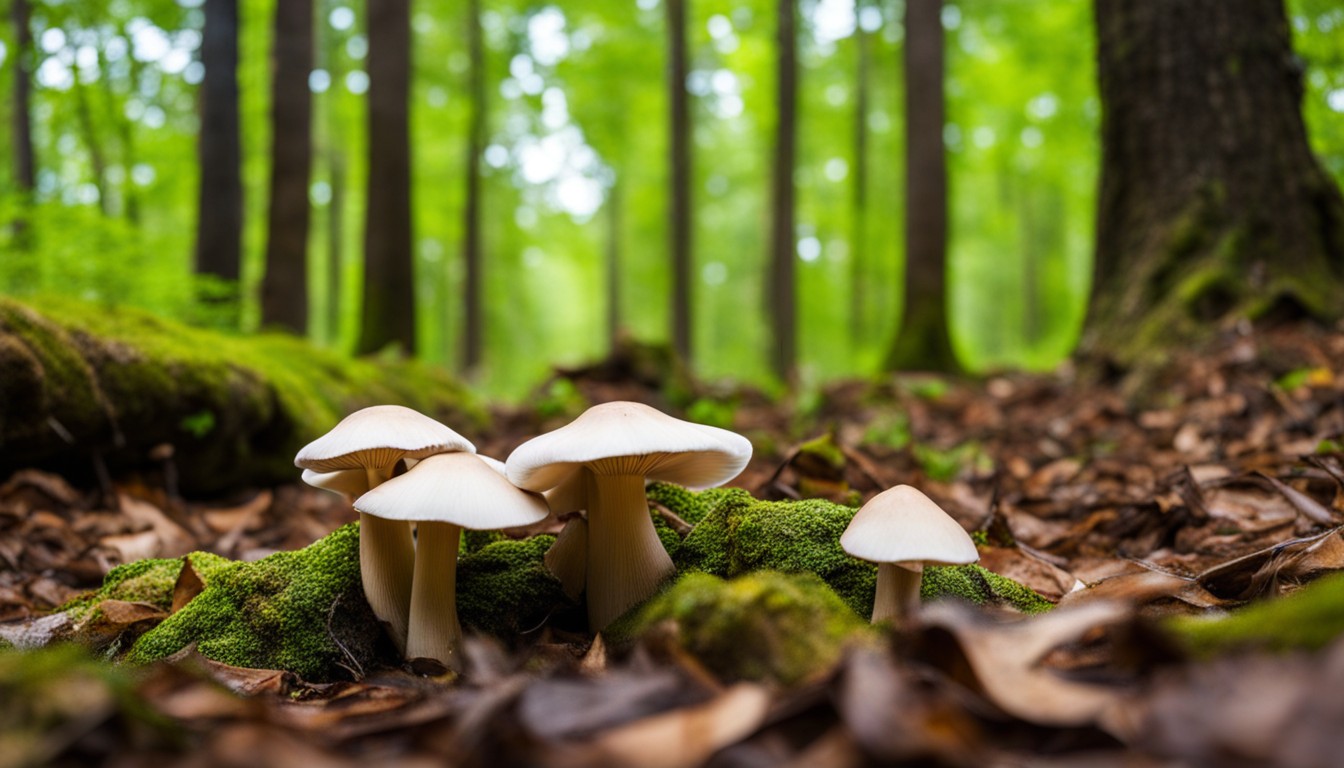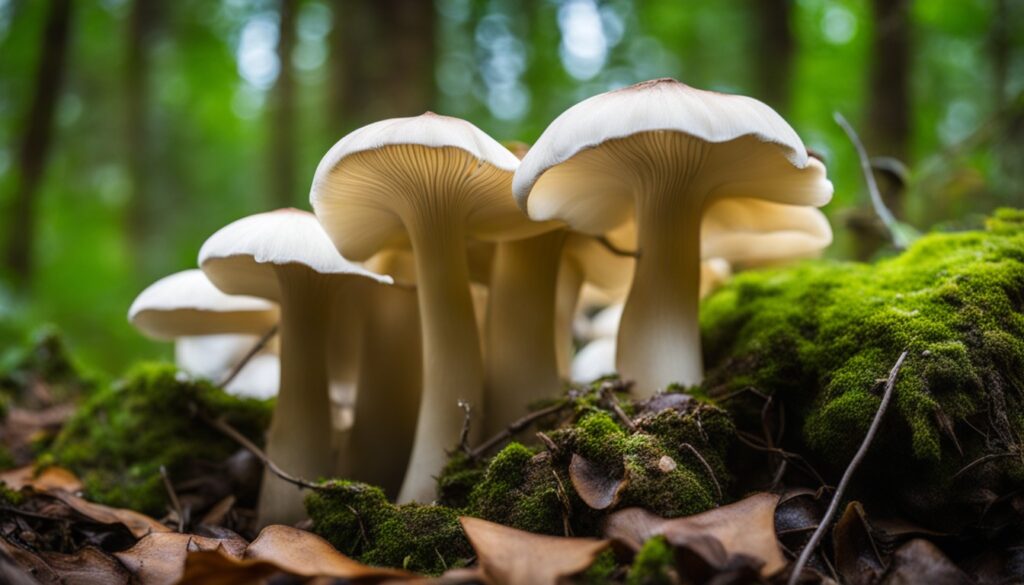Mushrooms of Washington State: A Comprehensive Guide offers an extensive exploration of the diverse and fascinating fungi found in the region. With its detailed descriptions, vibrant images, and expert insights, this blog post serves as an invaluable resource for both amateur mushroom enthusiasts and seasoned foragers. From identifying common species to providing tips on where and when to search for them, this comprehensive guide delves into the magical world of mushrooms in Washington State, captivating readers with its wealth of information.
Types of Mushrooms in Washington State
A rich tapestry of fungal life resides in Washington State, presenting an incredible variety of mushroom species. This state’s diverse ecology magnifies the vast array of specimens, including edible, poisonous, and medicinal categories.
Moreover, the morphologic diversity of Washington State mushrooms is a fascinating field of exploration, with consideration for not only their differing colors, sizes, and shapes, but also their distinctive growing conditions and habitat affinities.
Edible Mushrooms
In Washington State, you’ll encounter a myriad of edible mushrooms adored by gastronomes. With their exceptional flavors, they are a sought-after food source for culinary explorers and nature enthusiasts alike.
- Morel: Known for its nutty flavor and honeycomb-shaped cap.
- Chanterelle: Identified by its sunny yellow color and fruity aroma.
- Lobster: Noted for its bright red-orange hue and seafood-like taste.
- Porcini: Recognized by its fat stemmed cap and earthy flavor.
Poisonous Mushrooms
In the green corners of Washington State, not all mushrooms are a forager’s delight. Some, dubbed as ‘Dangerous Beauties,’ carry deadly toxins that pose serious health risks.
- ‘Amanita phalloides,’ commonly known as the death cap, recognized by its greenish cap and white gill and stem.
- ‘Amanita ocreata,’ or the destroying angel, marked by its pure white, deceivingly angelic appearance.
- ‘Galerina marginata,’ the deadly Galerina, typically small with brown caps blending with autumn leaves.
- ‘Cortinarius rubellus,’ the deadly webcap, easily identified by its rust colored gills and cap.
Medicinal Mushrooms
The pacific northwest flora doesn’t solely provide edible gems but also mushrooms with potent medicinal attributes. Indigenous tribes have acknowledged this for centuries, implementing species such as the Turkey Tail, Lion’s Mane, Chaga, and the Agarikon in folk medicine.
- Turkey Tail: Known for its immune-boosting capabilities and potential anticancer properties, these colorful mushrooms are a common sight in Washington’s moist forests.
- Lion’s Mane: This distinctive, fluffy white mushroom, often likened to a lion’s mane, has been recognized for promoting cognitive health.
- Chaga: Although not technically a mushroom, Chaga is a type of fungus with powerful antioxidant and anti-inflammatory effects, typically growing on birch trees.
- Agarikon: Identified as the longest living mushroom, Agarikon is native to the old-growth forests of Washington and is revered for its antiviral and antibacterial properties.
Where to Find Mushrooms in Washington State

Mapping the Mycelium unveils Washington’s diverse landscapes as a haven for fungi. Vibrant woodlands, enchanting alpine regions, and coastal areas teem with a wide variety of mushrooms waiting to be discovered.
Washington State boasts premium mushroom habitats; the rain-drenched forests, moss-covered mountain hummocks, and debris-laden coastal areas collectively host a variety of them.
A comprehensive understanding of mushroom habitats is intrinsic to successful foraging. The rainfall-enriched soil of forests, mossy hummocks in the mountains, and debris-rich beaches in the coastal areas are among the prime locations where mushrooms thrive in Washington State.
Forests and Woodlands
Hidden beneath the canopies of Washington’s forests and woodlands lie a myriad of mushroom varieties, each playing vital roles in maintaining a healthy ecosystem. These fungal treasures are integral parts of intricate symbiotic relationships with trees and plant life, supporting growth and recycling nutrients.
- Doug Fir King Bolete mushroom that particularly enjoys the company of Douglas fir trees
- Russula species that thrive in forest soils
- Hedgehog mushroom which often found under conifers or hardwood trees
- The Oyster mushroom, common on dying hardwood trees or logs
- Cauliflower mushroom highly adaptable to either coniferous or hardwood forests
Mountains and Alpine regions
The altitude and unique bio-climatic conditions of Washington’s mountains and alpine regions have led to a great diversity in mushroom species. It’s here that foragers can find delicacies such as king boletes, hawk wings, and the highly sought-after alpine puffballs.
- King Boletes: Recognizable by their large size and brown cap
- Hawk Wings: Known for their distinctive scale-like pattern on the underside
- Alpine Puffballs: Noted for their small, globular shape and preference for high-altitude habitats
Coastal Areas
In the study ‘Coastal Fungi,’ researchers discovered a myriad of mushroom species thriving along Washington’s rugged shorelines. These varieties are perfectly adapted to saline environments, manifesting the fascinating flexibility of fungi. A wealth of resources awaits foraging novices and experts alike.
The adaptability of mushrooms in Washington’s coastal areas is awe-inspiring. Despite the harsh, salty conditions, these fungi have evolved complex survival mechanisms, showcasing the incredible resilience of nature.
Washington’s coastal mushrooms are not just survivors, but ecological contributors too. They decompose organic matter washed ashore and contribute to nutrient cycling, playing a pivotal role in the coastal ecosystem’s harmony.
Mushroom Foraging Tips and Techniques

In Washington, identifying the fruiting body is key to successful mushroom foraging. Recognize the differing shapes, sizes, and colors; many edible species significantly differ from their poisonous lookalikes.
Foraging with focus ensures a successful mushroom hunt. Utilize tools like knives for cutting, brushes for cleaning, and baskets for carrying to avoid damage to delicate mushrooms and the surrounding environment.
Safety Precautions
When foraging for mushrooms in Washington State, prioritizing safety should be at the top of your list. Keep in mind that several fungi species appear enticing, but they can potentially be deadly if consumed. Therefore, learning to recognize toxic mushrooms is vital.
While familiar edible fungi like Morels or Chanterelle are fairly easy to identify, beginners should approach unrecognized varieties with extreme caution. A harmful mushroom can closely resemble an edible one, so when in doubt, err on the side of safety.
Foraging for mushrooms entails venturing deep into forested areas, so remember to follow general outdoor safety guidelines. This includes keeping track of your location, dressing properly, and carrying adequate supplies such as water and a first aid kit.
Equally important is understanding that all collected mushrooms should be thoroughly examined and cleaned before consumption. This ensures the elimination of any harmful bacteria or parasites that may be present.
Finally, always respect mushroom-related regulations in Washington. Certain areas restrict foraging to preserve the local ecosystem or due to high toxicity risks, so following these rules contributes greatly to overall safety and conservation.
Identifying Edible Mushrooms
To discern edible from inedible mushrooms in Washington, it’s vital to understand their unique features. Characteristics such as cap size, shape, color, gill type, and spore color can help distinguish between safe and harmful fungi.
Profound knowledge of mushroom morphology and an expert guidebook are cornerstones of identification. Observing features like stem texture, the presence of a veil, and the reactions of a mushroom to the changing environment aid in species identification.
A handful of mushroom species in Washington State recognized as friendly fungis include Chanterelles, Morels, Lobsters, and Porcinis. Their distinct characteristics, such as chanterelles’ trumpet-like shape or morels’ honeycomb cap, are key in identifying these edible varieties.
Proper Harvesting and Handling Techniques
Foraging responsibly is essential to preserving the unique fungi population in Washington. A key technique is careful harvesting, ensuring the base is left intact, as this promotes the species’ regeneration. Always handle mushrooms gently to prevent bruising, which can hasten spoilage.
When foraging, employ sustainable practices, such as using a mesh bag that allows spores to be dispersed back to the ecosystem for propagation. Harvest selectively, leaving the smaller, the old, and any rare species untouched, to help maintain the mushroom biodiversity.
It’s crucial that harvested mushrooms are stored properly. They should be kept in paper bags at cool temperatures to remain fresh, while noting down their type and harvesting location for traceability. Washing should be postponed until ready to use to avoid accelerated decay.
Tools and Equipment for Mushroom Foraging
Venturing into the woods of Washington for mushroom foraging requires appropriate gear. Essential tools include a knapsack to store your harvest, a sharp knife for precise cuttings, and a soft brush to remove dirt without damaging the fungi.
It is highly recommended to carry field guides and apps to help identify various mushroom species. Smart device with GPS is also crucial for tracking your routes and the locations of your finds.
When choosing mushroom foraging equipment, resilience should be paramount. Your toolkit should ideally be waterproof and durable enough to handle rugged terrains and varying weather conditions.
Personal safety is equally vital in the choice of equipment. Consider investing in a sturdy pair of boots, a hat or cap to shield from the element and possibly a whistle for emergencies while in the dense Washington forests.
Popular Edible Mushrooms in Washington State

A gourmet gathering awaits enthusiasts in the understory of Washington State, where a diversity of edible mushrooms flourish. Whether it’s the honey-combed cap of the Morel, the yellow sunburst of the Chanterelle, the crimson exterior of the Lobster, or the thick bulbous body of the Porcini, each offers unique flavors and culinary possibilities.
Popuplated with a vast species of fungi, discerning the edible from non-edible requires skill, which comes only from experience and proper knowledge. But the delight of discovering a feast tucked under the foliage, like Morels after a spring rain, Chanterelles in the summer, or Porcinis in the autumn, is an unmatched joy for every mushroom lover.
Morel Mushrooms
Characterized by their honeycomb texture and distinct flavor, morel mushrooms in Washington emerge primarily in spring. They’re favored by experienced foragers for their elusiveness, growing often near fallen trees or burns struck by previous wildfires.
Proper identification of morels is essential, given the existence of ‘false morels’, which can contain toxic compounds. True morels have a pitted and sponge-like cap, hollow stem, and their cap and stem are joined at the base.
Harvesting morels involves cutting them at the base, leaving the underground mycelium undisturbed. Remember, excessive harvesting could lead to future shortages, so ensure responsible foraging by only taking what you would reasonably need.
Chanterelle Mushrooms
Unearthing a classic in the vast forests of Washington State, Chanterelle Mushrooms offer a delight to the sense, both in taste and visual appeal. Known for their bright golden hue and fruity aroma, these fungi are a favorite among foragers.
Delicate in appearance with their trumpet-shaped caps, Chanterelles challenge this perception with their robust flavor, earning them a revered spot in culinary circles. They present a faint peppery bite that’s beautifully balanced with a hint of mild, nutty sweetness.
These mushrooms thrive in moist, temperate woodlands native to Washington. An adept forager, understanding their preferred habitats and seasonal appearance, can successfully unearth these gastronomic gems yearly, adding an earthy profusion to their cooking.
Lobster Mushrooms
A visually striking fungus indeed, the Lobster Mushroom from Washington state embraces a peculiar red-orange hue, mimicking the look of cooked lobster. Despite its otherworldly appearance, it is widely celebrated for its rich, slightly sweet, and meaty flavor.
Lobster mushrooms are found in abundance around Washington, gracing the undergrowth of hardwood forests during the late summer and autumn months. The unique, seafood-like taste of these mushrooms is a treat for the culinary adventurous.
There’s no denying that Washington’s Lobster Mushrooms has a distinct flavor profile. The subtle sweetness, coupled with an intriguing creaminess, delivers an enriching palette experience that instantly enriches any dish it’s added to.
Porcini Mushrooms
Often dubbed the ‘King of Mushrooms’, the Porcini mushroom holds great prestige among Washington’s natural pantheon. Known for their smooth caps and robust flavors, their gentle arrival in the region marks the beginning of the much-anticipated mushroom season.
Porcinis stand out with their thick stems and large brown caps, making them a coveted find for foragers. Found predominantly in pine forests, timing is crucial when hunting for these edible gems; heading out post-rainfall often yields the best specimens.
Harvesting requires precision, as it’s important not to damage the delicate mycelium. The use of a knife to gently cut the mushroom at its base ensures future generations. Once gathered, their nutty flavor and meaty texture make Porcinis a versatile ingredient in many dishes.
Fascinating Facts about Mushrooms
In the biosphere’s intricate web, Washington State mushrooms, whether mythic or medicinal, occupy a pivotal place, contributing to soil fertility, plant growth, and ecosystem balance.
From reputedly extending one’s life or fostering a trip into other dimensions, the lore-filled, medicinal realm of mushrooms in Washington State is as broad as it is fascinating, exploring new avenues in medicine and sustainability.
Role of Mushrooms in the Ecosystem
Fungi act as the unsung heroes of Washington’s Ecosystem, performing crucial roles such as acting as decomposers, ultimately aiding in the recycle of nutrients that ensure the health of the forests. Their underground mycelial networks transfer nutrients between plants, making them highly significant components of the ecosystem’s functionality.
Mushrooms contribute to the balance of Washington’s delicate ecosystem and biodiversity in ways often overlooked. Their ability to break down organic material and transform it into a substance usable by plants enables them to serve as integral nutrient recyclers.
Not just workers behind the scenes, mushrooms establish symbiotic relationships with various tree species, significantly boosting their growth and resilience. This important role illustrates the interconnected web of life existing within the wilderness of Washington State, where each component plays a vital part.
Mushrooms as Medicine
Harnessing the healing potential of mushrooms, Washington has become a hub for exploring the medicinal properties. Certain species abound with antioxidants, vitamins, and other essential nutrients instrumental for holistic well-being.
The local folk medicine has a rich history of using these medicinal mushrooms, integrating them into health practices to treat a range of ailments, from inflammation to enhancing immune systems.
Modern health practices have amplified this tradition, using extracts and preparations from fungi like Reishi and Lion’s Mane for their potential therapeutic benefits. These are getting recognized globally due to progressive research largely conducted in Washington.
Despite the extensive use and recognized potential, it’s essential to consult healthcare professionals before using mushrooms as medicine. Guided usage can safely harness the unconventional health-promoting powers these natural treasures offer.
Mushrooms and Sustainability
Fully grasping the role of fungus in sustainable agriculture, we cannot overlook the potential of mushrooms in this context. Their ability to thrive in varied conditions, consume waste material, and even restore contaminated soils make them an excellent part of Washington’s agricultural future.
Mushrooms play a crucial role in our ecosystem, acting as nature’s recyclers by breaking down organic matter. This unique characteristic enables mushrooms to be used in bioremediation projects, restoring the health of our environment and ensuring sustainability in the state’s ecosystem.
Shifting focus to the economic impact of sustainable mushroom harvesting in Washington, these forest gems are indeed an integral part of the state’s underground economy. Revenue from wild mushroom picking and cultivation propels an economic cycle that benefits local communities.
Harvesters, buyers, distributors, and restaurateurs, all contribute to and capitalize on the mushroom industry. The sustainable practices encouraged lend to a flourishing business model that invests in the preservation of Washington’s unique ecosystems thus perpetuating a cycle of prosperity.
Presently, ongoing research seeks to enhance sustainable mushroom farming even further. Given the versatility of mushrooms, hopes are high that through such initiatives, we will see a heightened role for mushrooms at the forefront of sustainable agriculture and economic growth in the state.
Frequently Asked Questions
What is the ecological role of mushrooms in Washington State?
Mushrooms play a vital role in the ecosystem of Washington State, acting as decomposers, breaking down organic matter and recycling nutrients, contributing to soil health and fertility.
What culinary charm do mushrooms in Washington State possess?
Washington State is home to a variety of delectable mushrooms that offer unique flavors and textures, adding depth and richness to culinary dishes, from the meaty porcini to the delicate chanterelles.
Are there any medicinal properties associated with mushrooms in Washington State?
Certain mushrooms found in Washington State have been traditionally used for their medicinal properties, with research suggesting potential benefits such as immune support, anti-inflammatory effects, and even potential anti-cancer properties.
How do mushrooms contribute to sustainability in Washington State?
Mushrooms have a low environmental impact and can be grown using organic waste materials, making them a sustainable food source and reducing the strain on natural resources in Washington State.
Where can I find mushrooms in Washington State?
Mushrooms can be found in a variety of habitats in Washington State, including forests, meadows, and even urban areas. It’s important to obtain proper identification and follow regulations to ensure responsible foraging practices.
Are there any poisonous mushrooms in Washington State?
Yes, Washington State is home to several toxic mushrooms, and it’s crucial to be able to differentiate between edible and poisonous species. Seek guidance from experienced foragers or mycologists for safe mushroom identification.
Conclusion
Spore Score takes us on a captivating journey into the unique world of Washington’s mushrooms. It magnifies the significant roles these organisms have in maintaining ecosystem balance.
As we reflect on the contributions of mushrooms in Washington State, let’s consider how they’re not only gastronomically esteemed but also hold medicinal benefits and represent sustainability.
- Promote ecological balance.
- Provide gastronomic delights.
- Offer medicinal benefits.
- Symbolize sustainability.

